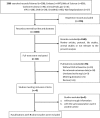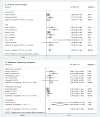Trimethylamine-N-oxide has prognostic value in coronary heart disease: a meta-analysis and dose-response analysis
- PMID: 31918665
- PMCID: PMC6953212
- DOI: 10.1186/s12872-019-01310-5
Trimethylamine-N-oxide has prognostic value in coronary heart disease: a meta-analysis and dose-response analysis
Abstract
Background: Previous clinical studies have suggested that trimethylamine-N-oxide (TMAO) could contribute to the development of atherosclerosis cardiovascular disease. However, the synthetic analysis in coronary heart disease (CHD) was not yet performed. We aimed to clarify the relationship between elevated plasma concentrations of TMAO and the incidence of major adverse cardiovascular events (MACE) in CHD patients.
Methods: Meta-analysis and dose-response analysis of hazard ratio data from prospective observational studies reporting on the association between TMAO plasma concentrations and the incidence of MACE in patients with CHD were conducted.
Results: Of the 2369 published articles identified in the search, seven papers, with data from nine cohort studies (10,301 patients), were included in the meta-analysis. Combined data showed that elevated plasma TMAO concentrations could increase 58% higher risk of MACE in patients with CHD (hazard ratios [HR]: 1.58; 95% confidence interval [CI] = 1.35-1.84, P = 0.000). For follow-up ≥ 1 year, it was associated with 62% higher risk of MACE in patients with longer-term than shorter-term (HR for follow-up ≥ 4 years: 1.96; 95% CI = 1.52-2.52 vs one to 3 years: 1.34; 95% CI = 1.26-1.43, P = 0.004). The dose-response analysis revealed a 'J' shaped association between TMAO concentration and the incidence of MACE (P = 0.033), with the concentration above 5.1 μmol/L being associated with HR of > 1.
Conclusions: Elevated levels of TMAO are associated with an increased incidence of MACE in patients with CHD. TMAO concentration of 5.1 μmol/L may be a cut-off value for prognosis.
Keywords: Coronary disease; Differential threshold; Dose-response relationship; Meta-analysis as topic; Trimethyloxamine.
Conflict of interest statement
The authors declare that they have no competing interests.
Figures



References
-
- Grabmaier U, Clauss S, Gross L, Klier I, Franz WM, Steinbeck G, et al. Diagnostic and prognostic value of miR-1 and miR-29b on adverse ventricular remodeling after acute myocardial infarction-the SITAGRAMI-miR analysis. Int J Cardiol. 2017;244:30–36. doi: 10.1016/j.ijcard.2017.06.054. - DOI - PubMed
Publication types
MeSH terms
Substances
Grants and funding
- 81573708/the National Natural Science Foundation of China/International
- 2015A030306049/the Guangdong Natural Science Funds for Distinguished Young Scholars/International
- YN2015MS21, YN2019MJ15/the Discipline of Integrated Chinese and Western Medicine in Guangzhou University of Chinese Medicine/International
- 2015TQ01R588/Special support plan for training high level talents in Guangdong Province/International
LinkOut - more resources
Full Text Sources

